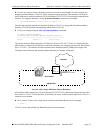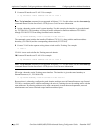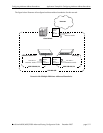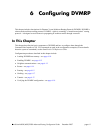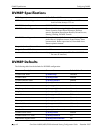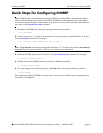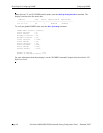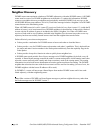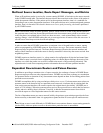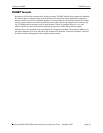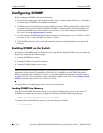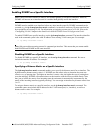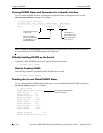
Configuring DVMRP DVMRP Overview
OmniSwitch 6800/6850/9000 Advanced Routing Configuration Guide December 2007 page 6-5
DVMRP Overview
Distance Vector Multicast Routing Protocol (DVMRP) Version 3 is a multicast routing protocol that
enables routers to efficiently propagate IP multicast traffic through a network. Multicast traffic consists of
a data stream that originates from a single source and is sent to hosts that have subscribed to that stream.
Live video broadcasts, video conferencing, corporate communications, distance learning, and distribution
of software, stock quotes, and news services are examples of multicast traffic. Multicast traffic is distin-
guished from unicast traffic and broadcast traffic as follows:
• Unicast traffic is addressed to a single host.
• Broadcast traffic is transmitted to all hosts.
• Multicast traffic is transmitted to a subset of hosts (the hosts that have subscribed to the multicast data
stream).
DVMRP is a distributed multicast routing protocol that dynamically generates per-source delivery trees
based upon routing exchanges, using a technique called Reverse Path Multicasting. When a multicast
source begins to transmit, the multicast data is flooded down the delivery tree to all points in the network.
DVMRP then prunes (i.e., removes branches from) the delivery tree where the traffic is unwanted.
Pruning continues to occur as group membership changes or routers determine that no group members are
present. This restricts the delivery trees to the minimum branches necessary to reach all group members,
thus optimizing router performance. New branches can also be added to the delivery trees dynamically as
new members join the multicast group. The addition of new branches is referred to as grafting.
Reverse Path Multicasting
DVMRP uses Internet Group Management Protocol (IGMP) messages to exchange the routing informa-
tion needed to build per-source multicast delivery trees. Once built, packets follow a multicast delivery
tree from the source to all members of the multicast group. Packets are replicated only at necessary
branches in the delivery tree. The trees are calculated and updated dynamically to track the membership of
individual groups.
When a packet arrives on an interface, the reverse path back to the source of the packet is determined by
examining a DVMRP routing table of known source networks. If the packet arrived on an upstream inter-
face that would be used to transmit packets back to the source, it is forwarded to the appropriate list of
downstream interfaces. Otherwise, it is not on the optimal delivery tree and is discarded. In this way dupli-
cate packets can be filtered when loops exist in the network topology.



